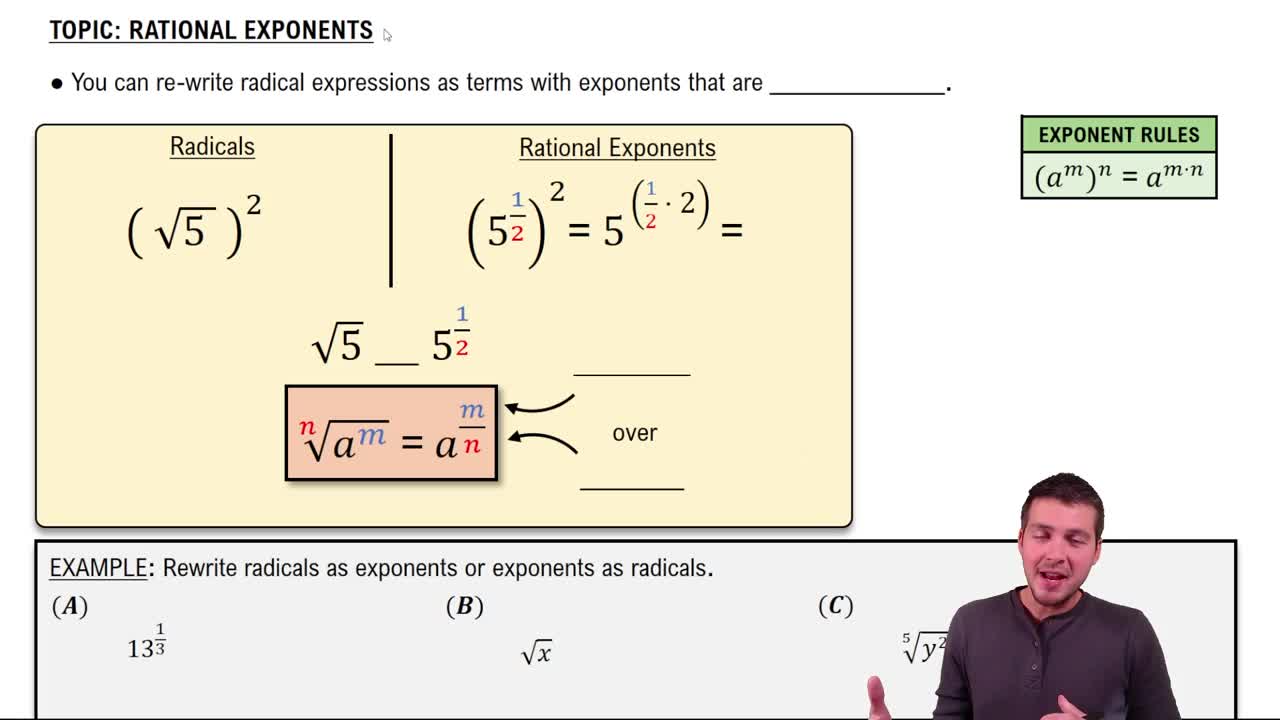Table of contents
- 0. Review of Algebra4h 16m
- 1. Equations & Inequalities3h 18m
- 2. Graphs of Equations43m
- 3. Functions2h 17m
- 4. Polynomial Functions1h 44m
- 5. Rational Functions1h 23m
- 6. Exponential & Logarithmic Functions2h 28m
- 7. Systems of Equations & Matrices4h 6m
- 8. Conic Sections2h 23m
- 9. Sequences, Series, & Induction1h 19m
- 10. Combinatorics & Probability1h 45m
6. Exponential & Logarithmic Functions
Properties of Logarithms
Problem 37a
Textbook Question
In Exercises 1–40, use properties of logarithms to expand each logarithmic expression as much as possible. Where possible, evaluate logarithmic expressions without using a calculator. ln[(x^3(√(x^2 + 1))/(x + 1)^4]
 Verified step by step guidance
Verified step by step guidance1
<Apply the logarithm of a quotient rule: \( \ln\left(\frac{a}{b}\right) = \ln(a) - \ln(b) \).>
<Apply the logarithm of a product rule: \( \ln(ab) = \ln(a) + \ln(b) \).>
<Apply the power rule for logarithms: \( \ln(a^b) = b \cdot \ln(a) \).>
<Simplify each term separately using the rules above.>
<Combine all simplified terms to express the expanded form of the logarithmic expression.>
Recommended similar problem, with video answer:
 Verified Solution
Verified SolutionThis video solution was recommended by our tutors as helpful for the problem above
Video duration:
3mPlay a video:
Was this helpful?
Key Concepts
Here are the essential concepts you must grasp in order to answer the question correctly.
Properties of Logarithms
The properties of logarithms include rules that simplify the manipulation of logarithmic expressions. Key properties include the product rule (log(a*b) = log(a) + log(b)), the quotient rule (log(a/b) = log(a) - log(b)), and the power rule (log(a^b) = b*log(a)). Understanding these properties is essential for expanding logarithmic expressions effectively.
Recommended video:

Change of Base Property
Natural Logarithm (ln)
The natural logarithm, denoted as ln, is the logarithm to the base e, where e is approximately 2.71828. It is commonly used in calculus and higher mathematics. Recognizing that ln has specific properties similar to other logarithms helps in applying the logarithmic rules correctly when expanding expressions.
Recommended video:

The Natural Log
Radicals and Exponents
Radicals, such as square roots, can be expressed as exponents (e.g., √(x) = x^(1/2)). This understanding is crucial when dealing with logarithmic expressions that involve roots, as it allows for the application of the power rule in logarithms. Converting radicals to exponent form simplifies the expansion process.
Recommended video:
Guided course

Rational Exponents

 3:49m
3:49mWatch next
Master Product, Quotient, and Power Rules of Logs with a bite sized video explanation from Callie
Start learningRelated Videos
Related Practice







